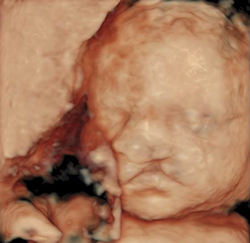Cleft Lip/Palate
 A cleft lip/palate happens when the lip edges and/or palate fail to fuse together in early development. Most of these conditions are random, meaning they are not related to another genetic or medical condition. However, there are times when clefting can be related to genetic conditions or certain medications.
A cleft lip/palate happens when the lip edges and/or palate fail to fuse together in early development. Most of these conditions are random, meaning they are not related to another genetic or medical condition. However, there are times when clefting can be related to genetic conditions or certain medications.
Prenatal Diagnosis
If a cleft lip is found prenatally at another hospital, you may be referred to UR Medicine's Maternal-Fetal Medicine team. Our team will perform a detailed Level II ultrasound to help determine if there are other findings, review your genetic history, and offer testing for certain conditions related to clefting. You will also be offered the opportunity to meet with our cleft surgery team, prenatally, to discuss feeding strategies and to learn about the general timeline of care for your child.
Approximately 100 infants with cleft have been imaged and evaluated by the our team in the last five years. It is important to note that while cleft lip is often (but not always) found before birth, cleft palate is often diagnosed after birth as the palate is much more difficult to visualize prenatally.
Infant Care
Most infants with this finding will not need delivery at UR Medicine's Golisano Children's Hospital, but will need to follow-up with our craniofacial surgery team soon after birth to make sure feeding, breathing, and weight gain are adequate. Because the nose, lips, and palate may all be affected, infants with these conditions need a specialized team to help them thrive!
The Pediatric Craniofacial team at Golisano Children's Hospital offers the region's only center dedicated to the needs and treatment of children born with cleft lip, cleft palate, and other craniofacial anomalies.
Each year the craniofacial team sees around 400 patients in a comprehensive multidisciplinary format. Our Pediatric Plastic and Craniofacial Surgery Program performs around 450 operations annually on children throughout the region. The Pediatric Craniofacial team also offers nasoalveolar molding (NAM) as a presurgical optimization tool for more complex cleft lip patients.
Our fetal care coordinator can help arrange the opportunity to meet this team before your delivery.